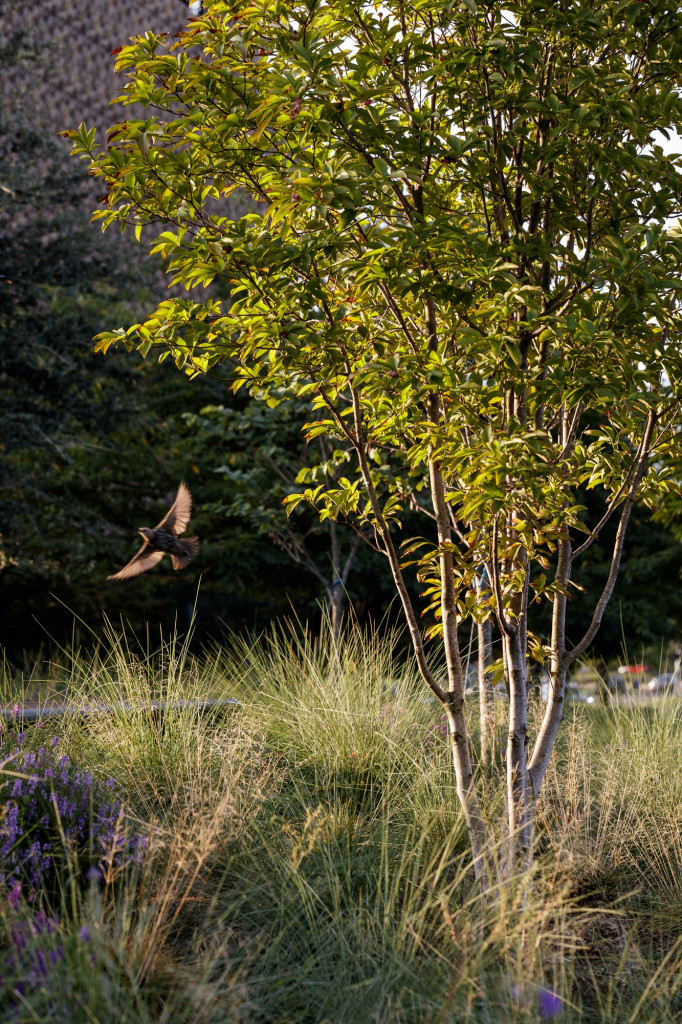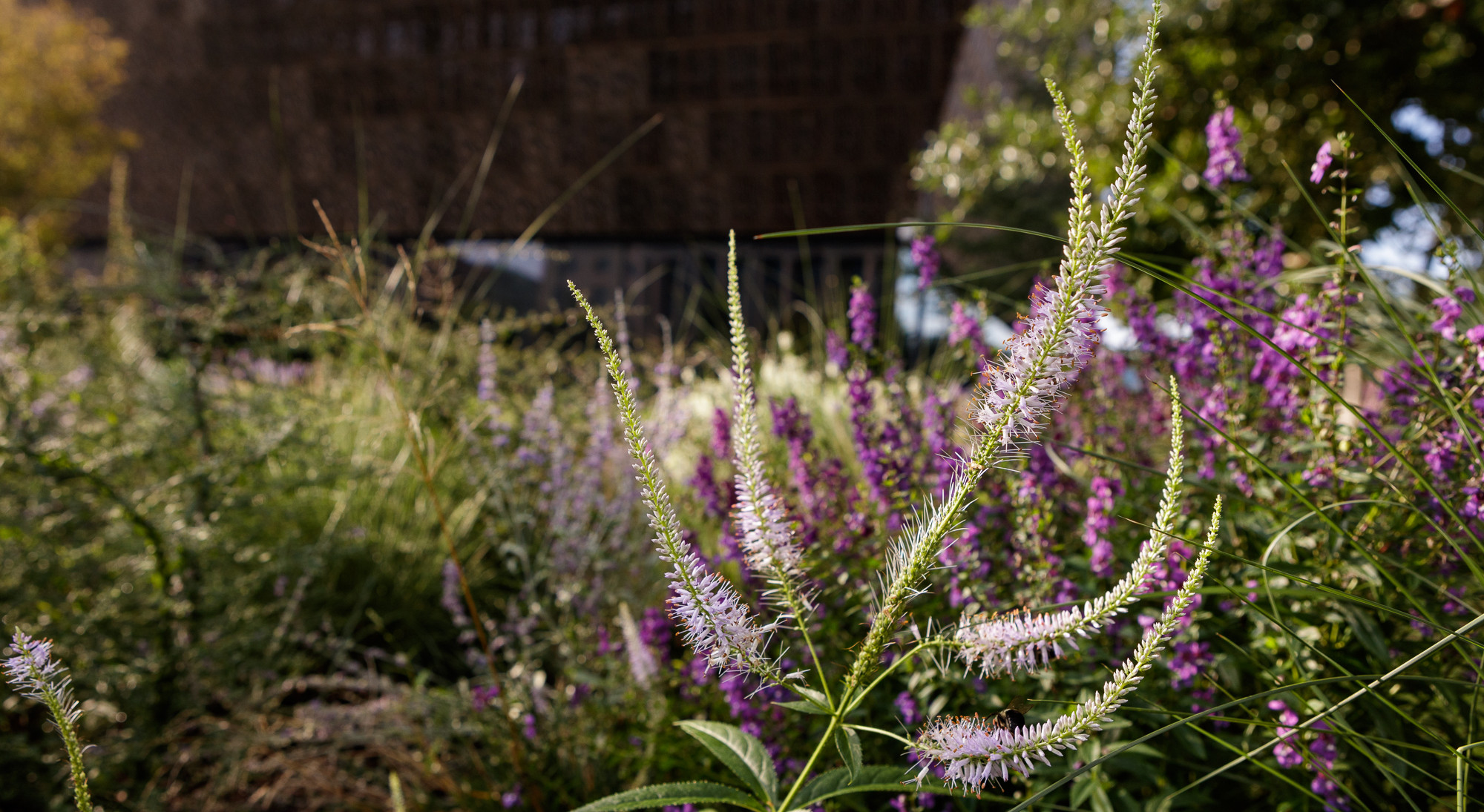Culture, Community, and Connection in the Gardens at the National Museum of African American History and Culture
Change is happening in the gardens around the Smithsonian’s National Museum of African American History and Culture (NMAAHC). If you’ve visited recently, you may have noticed the transformations. The landscape is maturing as it completes its seventh year in the ground. Trees have established and reach for the sky while woody shrubs fill their borders. Every spring, early-season flowering trees such as the native fringe tree (Chionanthus virginica), various Magnolia species, white flowering redbuds (Cercis canadensis f. alba), and Yellowwood (Cladastris kentuckea) greet visitors. The familiar ‘Yoshino’ Cherries (Prunus x geodesist ‘Yoshino’) to the west of the site reference D.C.’s world-famous Tidal Basin display just beyond the grounds of the nearby Washington Monument during the spring. Summer hydrangea cultivars (H. paniculata) fill the southern border with lush white blooms. All while our beloved southern live oaks (Quercus virginiana) continue to thrive despite living in a location north of their hardiness boundary. The garden and its graceful walks are simply stated with elegant lines that complement the museum’s architecture and encourage people to move through the site. Our gardens are growing up!
The original design of the garden, by the Seattle-based landscape architecture firm Gustafson, Guthrie, and Nichol (GGN), established a solid foundation for the space to address dual goals of integrating the building and site into the context of the Washington Monument grounds while simultaneously creating a unique identity for the building. The design also guides Smithsonian Gardens staff as we think about the future and reflect on both the successes and shortcomings of the garden. Eight years after opening, we enjoy strong working relationships with our colleagues inside the museum, we better understand how our visitors use the space, and we’ve developed a renewed focus on our goals.

At Smithsonian Gardens, our vision is to be both a living classroom and an urban sanctuary that meet the critical challenges of understanding and sustaining a biodiverse planet as well as interpreting the roles that gardens play in preserving American history in a global context. As a museum that’s been accredited by the American Alliance of Museums, Smithsonian Gardens seeks to extend the Smithsonian Museum experience to the curb. We garden for beauty and for meaning within the context of the Smithsonian community. One way we do this is by adding interpretive layers to our traditional floral displays that keep the original design intent in mind. We began this process in 2019 as part of our campus wide exhibition, Habitat. In this garden we installed ‘Sheltering Branches’ where we looked at the African American experience through the lens of the southern Live Oak tree. Both NMAAHC curators and SG horticulturists worked together to interpret the idea of habitat as a safe space and discuss the role of the Live Oak tree in American history. The interpretive panels are now a permanent part of the garden.
This year we are celebrating a new garden in the landscape which incorporates a mix of ornamental grasses and flowering perennials that adorn the Hope and Optimism Reading Grove in the northwest corner of the site. This garden infuses new meaning into an existing space that increases the garden’s sustainability and visitor usage and expands cultural interpretation. Additionally, the garden puts to use SG’s “Soils Management Plan.” that outlines best practices to help ensure the health of the soils used throughout the Smithsonian campus which in turn enable the plants and trees to flourish. A comprehensive study of the garden soils at NMAAHC highlighted the excessive amounts of resources (water, fertilizer, etc.) required to maintain this site to our standards.
Last winter, the reading grove project began with soil improvements that replaced the existing sandy soils with a “live” loamy, clay soil rich with micronutrients and biological activity. Without adding significant weight, this soil increases water retention and the ability to hold nutrition for almost 4,000 square feet of turf grass. We then replaced the 4,000-square-foot monoculture of lawn with a rich mix of native and non-native perennials and grasses. The new plantings now attract a range of pollinators and increase the site’s beauty and biodiversity. The once sparse reading grove is now nestled into a vibrant display of color and diversity that requires less resources to be successful.

and Culture. Hannele Lahti, photographer.
The new, more resource-efficient garden also adds opportunities for cultural interpretation to the landscape. One plant whose bloom season is quickly approaching is pink muhly grass (Muhlenbergia capillaris). Indicative of coastal Georgia and South Carolina ecologies and reminiscent of coastal sand dunes, Muhlenbergia, or sweetgrass, spreads out along the back hillside of the reading grove. Sweetgrass is one of the plants used by African American artisans in these coastal communities, many of whom identify as Gullah or Geechee, to weave their iconic baskets. SG features this grass not just because of its symbolic significance to these communities but because it relates directly to some of the many stories and collections items on display inside the museum. If you visit the museum’s third floor, you can learn how woven sweetgrass fanner baskets were used by enslaved people in these coastal communities to separate rice grains from their husks during rice processing. Walk up another level and admire the detail of one of these traditional baskets on display woven by artist Mary A. Jackson.
The refurbished reading grove garden represents the next stage of growth for the gardens around the National Museum of African American History and Culture. It is symbolic of the fact that the Smithsonian gardens do not exist in a void. They are works of horticultural art layered with symbolism and greater meaning. It is our hope at Smithsonian Gardens that these gardens speak to our visitors in a meaningful way that not only satisfies their desire for beauty but also engages them in a wider context of community, history, and culture.

